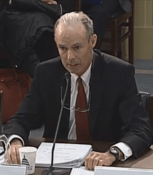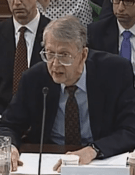From left: Steve Berry, Thomas Murray and LeRoy Carlson Jr. Photos by Leslie Stimson, Inside Towers
Access to broadband, both rural and urban, is a bi-partisan issue, lawmakers agreed Tuesday in a House Communications and Technology Subcommittee hearing on removing barriers to infrastructure deployment. Subcommittee Chair Rep. Marsha Blackburn (R-TN), said: “We are all tired of hearing stories about parents driving their children to the local McDonald’s for internet access in order to finish homework assignments. We owe them better, period. The 5G revolution is upon us and we should modernize our laws to address issues such as tower siting and federal rights-of-ways, which are tying the hands of our private sector.”
Congress should streamline infrastructure deployment, said Competitive Carriers Association President/CEO Steven Berry. “Wireless carriers need to deploy towers.” For small cells in particular, the siting process is a “regulatory nightmare,” he said, saying small cells are the size of a pizza box, yet are regulated like tall towers.
There needs to be a definition of how tall a small cell is, said Thomas Murray, founder and managing member of Community Wireless Structures, and chairman of the board for the Wireless Infrastructure Association. “Some say 120-feet is small; it’s not.” He believes a “reasonable definition could be a structure 50 feet or less,” which would get expedited review and anything taller subject to normal municipal review.
Berry and LeRoy Carlson Jr., CEO, Telephone and Data Systems, Inc. and chairman of U.S. Cellular, agreed 4G is not fully deployed. That needs to be done first, because “5G is meant to be integrated with 4G. We need 4G to be ubiquitous,” said Carlson. He also said: “We need all the help we can get with backhaul. We connect a lot of cell sites with microwave” technology.
Also, several witnesses agreed the FCC needs to update its carrier coverage maps. “Instructions to carriers to fill out Form 477 do not produce accurate maps,” said Carlson. Good maps would show where coverage is good and where it’s weaker. He suggested this “flaw” be addressed before the FCC distributes Mobility Fund money.
The subcommittee is drafting legislation to address these issues.
March 22, 2017







Reader Interactions